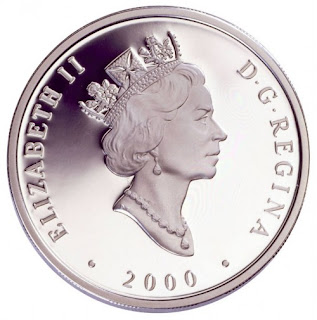Canada 20 Dollars Silver Coin 2000 The Toronto locomotive
Transportation Series
Obverse: Right-facing profile of Her Majesty Queen Elizabeth II by artist Dora de Pédery-Hunt, along with the year and face value.
Lettering: ELIZABETH II D • G • REGINA 2000.
Engraver: Dora de Pédery-Hunt.
Reverse: The Toronto locomotive with cameo hologram. "Toronto," the First Locomotive Built in Canada.
Lettering: CANADA 20 DOLLARS.
Engraver: Bonnie Ross.
Mintage: 44367.
Composition: 92.5% silver, 7.5% copper.
Finish: proof.
Weight: 31.1 g.
Diameter: 38 mm.
Edge: serrated.
Face value: 20 Canadian Dollars.
Artist: Bonnie Ross, William Woodruff (reverse), Dora de Pédery-Hunt (obverse).
Manufacturer: Royal Canadian Mint.
Transportation Series
Transportation on Land, Sea and Rail Collection
The 2000 Transportation Series is the first set in a three year series. Each coin in the series has a $20 face value and features a hologram depicting each form of transportation. The series focuses on Canadian innovations in transportation on land, sea, and rail that contributed to our rich Canadian transportation history.
2000
2001
2002
The recent movement of steam locomotive No. 6213 from the Exhibition Grounds to Roundhouse Park echoes one of the most important events in Toronto's early railway history. Construction on the Ontario, Simcoe & Huron, Toronto's first railway, began in 1852. Since there was no locomotive factory in existence in Canada at the time, the OS&H ordered their first engine from the United States.
Built by the Portland Company in Portland, Maine, the engine was named the "Lady Elgin", in honour of the wife of the governor-general, the Earl of Elgin. She had turned the first sod of the Ontario, Simcoe & Huron Railway in October 1851 on the site of today's InterContinental Hotel at Front and Simcoe Streets.
Four days after being delivered to Toronto from Portland, Maine, the "Lady Elgin", the first steam locomotive to run in Canada West (Ontario), began operating at Queen's Wharf (Lakeshore Boulevard & Bathurst Street) while a large crowd of onlookers cheered the event. In 2009, 6213 passed within a few yards of this location on its June 4 journey from the Exhibition Grounds to Roundhouse Park.
The OS&H was unhappy with the extra costs incurred by customs duties as well as shipping the locomotive across Lake Ontario and sought a local builder for its next locomotive. The Lady Elgin was mostly used in construction work on the Ontario, Simcoe & Huron Railway. The engine proved underpowered and troublesome and was relegated to secondary operation by the time the railway began revenue service in 1853.
.
A local foundry owner named James Good decided that there was money to be made supplying steam locomotives to the burgeoning railway industry and the Toronto Locomotive Works was established at Yonge and Queen Streets, about where St. Michael's Hospital is today.
On April 16, 1853, the "Toronto", was completed at Good's foundry. This was the first steam locomotive built in Canada, and probably the first anywhere in the British Empire outside of Great Britain. The 4-4-0 weighed almost 30 tons and was 26 feet in length without her tender. Her four driving wheels were five and a half feet in diameter. On April 18, the "Toronto" was moved outside the locomotive works onto Queen Street for display to an appreciative public, who came from all over the city and suburbs to see it.
On April 20, the ponderous journey of the steam locomotive "Toronto" began. The 30-ton locomotive was far too heavy for the horse-drawn float used to move the tender the previous day. As in 2009, the locomotive would take a different route than the tender. Temporary track was laid relay-fashion 100 feet at a time and the engine was crow barred into motion west along Queen Street. At York Street the Toronto was swiveled south towards Front Street. This laborious process occupied almost a week, much to the fascination of Torontonians who had never seen such an enormous machine. People gathered along the route to cheer the progress of the locomotive through the streets, just as enthusiastic railfans would stay up all night to pace the progress of 6213 in 2009. Fortunately today's enthusiasts didn't have to wait as long. The Toronto didn't complete its week-long journey until April 26, 1853. For the next three weeks, the railway broke in the locomotive and the engineers became familiar with its operation before it was sent out on its first revenue trip.
On May 16, 1853, the most historic day in Toronto railway history the Ontario, Simcoe & Huron Railway initiated revenue railway service for the first time. The wooden depot was located close to where the eastern entrance to Union Station is today. The locomotive "Toronto" pulled the four car mixed train consisting of a coach, a combine and two boxcars to Machell's Corners, 30 miles north of the city. A year later the community was renamed Aurora.
The Toronto Locomotive Works (TLW) was seriously hindered by its inconvenient location a mile north of the rail corridor. After unsuccessfully trying to relocate to the waterfront, the TLW abandoned the railway business in 1859 after building 23 locomotives.

